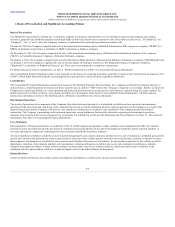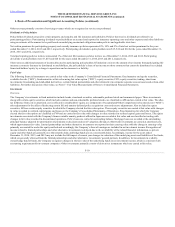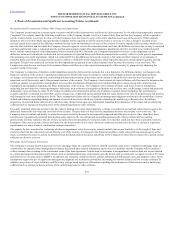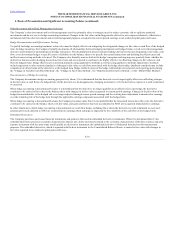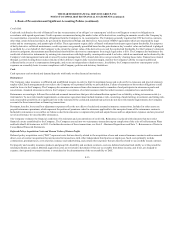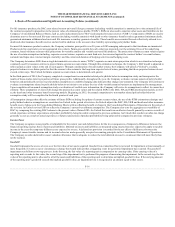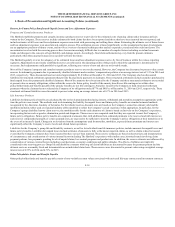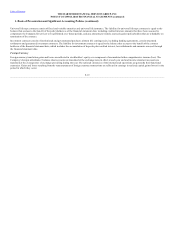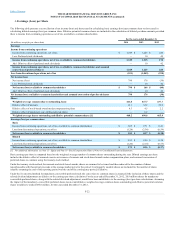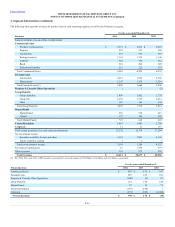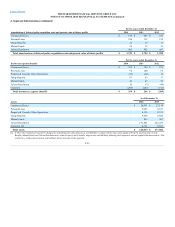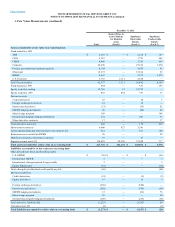The Hartford 2014 Annual Report Download - page 153
Download and view the complete annual report
Please find page 153 of the 2014 The Hartford annual report below. You can navigate through the pages in the report by either clicking on the pages listed below, or by using the keyword search tool below to find specific information within the annual report.
Table of Contents
Reserve for Future Policy Benefits and Unpaid Losses and Loss Adjustment Expenses
Property and Casualty Insurance Products
The Hartford establishes property and casualty insurance products reserves to provide for the estimated costs of paying claims under insurance policies
written by the Company. These reserves include estimates for both claims that have been reported and those that have been incurred but not reported, and
include estimates of all losses and loss adjustment expenses associated with processing and settling these claims. Estimating the ultimate cost of future losses
and loss adjustment expenses is an uncertain and complex process. This estimation process is based significantly on the assumption that past developments
are an appropriate predictor of future events, and involves a variety of actuarial techniques that analyze experience, trends and other relevant factors. The
uncertainties involved with the reserving process have become increasingly difficult due to a number of complex factors including social and economic
trends and changes in the concepts of legal liability and damage awards. Accordingly, final claim settlements may vary from the present estimates,
particularly when those payments may not occur until well into the future.
The Hartford regularly reviews the adequacy of its estimated losses and loss adjustment expense reserves by line of business within the various reporting
segments. Adjustments to previously established reserves are reflected in the operating results of the period in which the adjustment is determined to be
necessary. Such adjustments could possibly be significant, reflecting any variety of new and adverse or favorable trends.
Most of the Company’s property and casualty insurance products reserves are not discounted. However, the Company has discounted to present value certain
reserves for indemnity payments due to permanently disabled claimants under workers’ compensation policies at an average interest rate of 3.5% in 2014 and
2013, respectively. These discounted reserves totaled approximately $1.0 billion at December 31, 2014 and 2013. The Company also has discounted
liabilities for structured settlement agreements that provide fixed periodic payments to claimants. These structured settlements include annuities purchased to
fund unpaid losses for permanently disabled claimants. Most of the annuities have been issued by the Company and these structured settlements are recorded
at present value as annuity obligations, either within the reserve for future policy benefits if the annuity benefits are life-contingent or within other
policyholder funds and benefits payable if the annuity benefits are not life-contingent. Annuities issued by the Company to fund structured settlement
payments where the claimant has not released the Company of its obligation totaled $776 and $805 as of December 31, 2014 and 2013, respectively. These
structured settlement liabilities were discounted to present value using an average interest rate of 6.7% in 2014 and 2013.
Life Insurance Products
Liabilities for future policy benefits are calculated by the net level premium method using interest, withdrawal and mortality assumptions appropriate at the
time the policies were issued. The methods used in determining the liability for unpaid losses and future policy benefits are standard actuarial methods
recognized by the American Academy of Actuaries. For the tabular reserves, discount rates are based on the Company’s earned investment yield and the
morbidity/mortality tables used are standard industry tables modified to reflect the Company’s actual experience when appropriate. In particular, for the
Company’s group disability known claim reserves, the morbidity table for the early durations of claims is based exclusively on the Company’s experience,
incorporating factors such as gender, elimination period and diagnosis. These reserves are computed such that they are expected to meet the Company’s
future policy obligations. Future policy benefits are computed at amounts that, with additions from estimated premiums to be received and with interest on
such reserves compounded annually at certain assumed rates, are expected to be sufficient to meet the Company’s policy obligations at their maturities or in
the event of an insured’s death. Changes in or deviations from the assumptions used for mortality, morbidity, expected future premiums and interest can
significantly affect the Company’s reserve levels and related future operations.
Liabilities for the Company’s group life and disability contracts, as well as its individual term life insurance policies, include amounts for unpaid losses and
future policy benefits. Liabilities for unpaid losses include estimates of amounts to fully settle known reported claims, as well as claims related to insured
events that the Company estimates have been incurred but have not yet been reported. These reserve estimates are based on known facts and interpretations
of circumstances, and consideration of various internal factors including The Hartford’s experience with similar cases, historical trends involving claim
payment patterns, loss payments, pending levels of unpaid claims, loss control programs and product mix. In addition, the reserve estimates are influenced by
consideration of various external factors including court decisions, economic conditions and public attitudes. The effects of inflation are implicitly
considered in the reserving process. Group life and disability contracts with long tail claim liabilities are discounted because the payment pattern and the
ultimate costs are reasonably fixed and determinable on an individual claim basis. These reserves were discounted to present value using a weighted average
interest rate of 4.53% in 2014 and 4.71% in 2013.
Other Policyholder Funds and Benefits Payable
Other policyholder funds and benefits payable consist of non-variable account values associated with universal life-type contracts and investment contracts.
F-18


